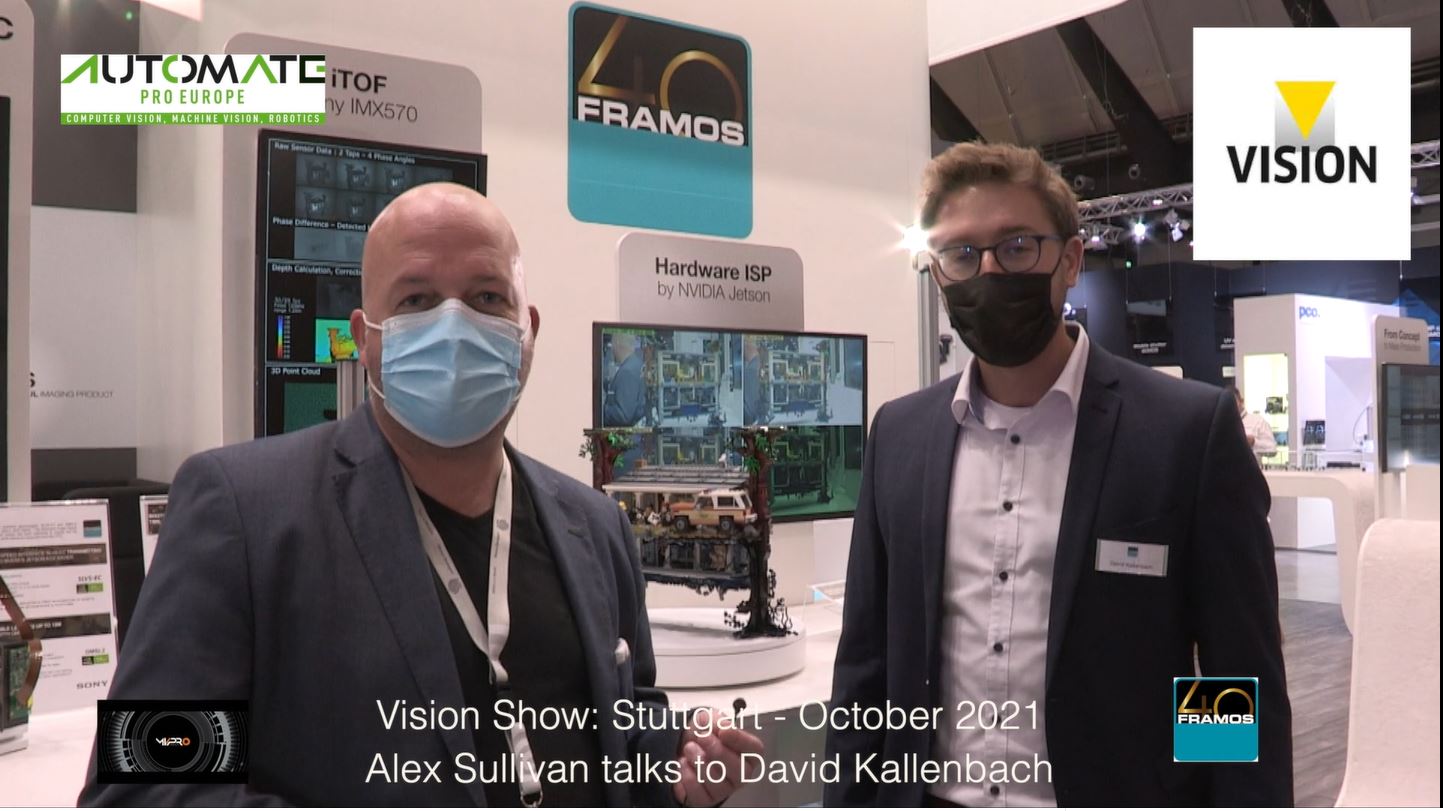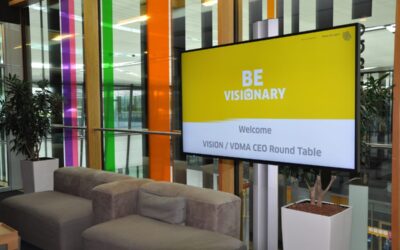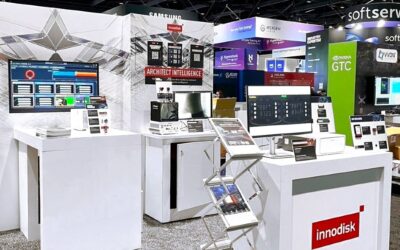[Alex] Good afternoon, readers. I’m delighted to be joined here today by David Kallenbach at the FRAMOS booth at the VISION show in Stuttgart. David, perhaps you could introduce yourself and tell us a little bit about FRAMOS?
[David] Yes, for sure. My name is David Kallenbach. I’m working for FRAMOS as a Field Application Engineer, so this makes me the technical contact person to FRAMOS. And I’m going to tell you today about what we’re showing here at the VISION [show] 2021. Obviously, as you can see, we at FRAMOS are trying to help our customers get the most out of their image. So this is all about a certain portfolio and how to get access to this certain portfolio and how to get access to the latest technologies.
We have a couple of technology demonstrations over here starting off with this Sony iToF, here in the middle. So that’s a brand new Sony IMX570. How we get access to it [is] via a modular platform on the Xavier Jetson platform. Then also, we have over here some digital overlap HDR demos utilising the Jetson ISP tuning.
Over here, we have some TMSL demos showing how to use the MIPI interface on longer cable lengths. That means up to 50 metres and all of this is based on our FRAMOS modular ecosystem. So that means we have the Sony portfolio on the one hand side giving access to all the technologies from Sony, be it global shutters or rolling shutters and polarised, event-based, but also ToF and SWIR as an example.
And then here we have all the demos showing how we can get access to all of these technologies. So that means we’re using our FRAMOS FSM (FRAMOS Sensor Modules) ecosystem, using the Jetson platform as an example and showing, let’s say, on the demos here, how to get image streaming accessible. That is the idea. Over here we have some more demos that say on the other hand when it comes to event-based and SWIR technology.
Here next to me, on the right-hand side, we have some demos where we show how to make these most accessible also for mass production. That means when it comes to going from prototyping and proof of concept, down all the way to mass production and productisation. And then on the backside here on spot one, we have shown several different technologies that are available from Sony, as mentioned before and also from the FRAMOS FSM ecosystem.
In the corner over here, we also show some technologies around Intel RealSense. That means we have the standard Intel RealSense products, but also the FRAMOS industrialised versions of it. So that’s the FRAMOS D400e products. So all in all, as mentioned, we’re showing how to make imaging easy, how to make imaging accessible using the FRAMOS FSM ecosystem.
[Alex] So what are the key applications? Is it really anyone who’s looking for machine vision systems from FRAMOS? Tell me who should be talking to you.
[David] Yes, indeed. If you want to build a camera depending on your experience level, we can start either by just selecting the right components for you, be it sensor selection or lens selection that means [the] selection of components around imaging down to the, let’s say full camera development. That means if you need, for example, the vision front-end, as long as the processing is excluded, you’ll be using our FSM ecosystem as the vision front-end provider.
[Alex] And how can our readers perhaps get in touch with FRAMOS?
[David] To get in touch obviously, just visit us at our booth if you are at the VISION show right now. Other than that, obviously, just contact us via our webpage contact formula or just give us a call. The telephone number is also given on the webpage and we’re happy to get in touch with you to discuss your projects.
[Alex] Excellent. Thank you very much, David. I’m just going to ask a couple of other questions if that’s okay, just to drop in slowly because you spoke really well about a lot of stuff and we’ve covered a lot of stuff. So, David, in regards to this product you’re demonstrating here, what are the key applications?
[David] So typically, I mean for ToF, obviously, we’re talking about a 3D application. That means 3D, you can use LIDAR, you can use ToF, you can use 3D stereo – and here, in [the] case of B, if you want to use an embedded, let’s say, ToF system at the range of about one to, let’s say 10 metres distance measurements and you want to have higher accuracy in the measurement.
And this can be one setup where you can integrate, let’s say, the depth measurements into your embedded system. So that means, let’s say, autonomous logistics vehicles, for example, autonomous robots and then pick and play, bin picking and things like this. This is where a system like the Sony iToF IMX570 and the embedded systems around it can be utilised.
[Alex] That’s fantastic. And are there any other application areas for the other products you mentioned? Can you give us some real-life examples or case studies?
[David] I can’t give you too many concrete examples, of course. But anyway, let’s think about any kind of industrial, let’s say, imaging applications and maybe a little bit away from the classic machine vision and maybe more towards the embedded, let’s say, consumer end-product, consumer type of applications. [That’s] be it image streaming, be it say object avoidance, [it] can be drones, [it] can be autonomous vehicles, [it] can be any type of imaging applications you can think of.
[Alex] Fantastic. That’s great. Thank you ever so much for joining us today.
[David] Okay, you’re welcome!
You can find more information about FRAMOS on its website.
Stay up to date with the most recent automation, computer vision, machine vision and robotics news on MVPro. Read the best stories every Friday with our newsletter.





